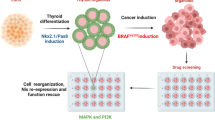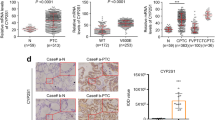Abstract
Current genetic evidence in mice indicates that SIRT1 has potent tumor suppressor activity in a variety of cancer models, with no evidence yet for SIRT1 oncogenic activity in vivo. We report here that transgenic Sirt1 expression is oncogenic in murine thyroid and prostate carcinogenesis initiated by Pten-deficiency. Based on mRNA expression analyses of pre-tumoral murine thyroids, we find that SIRT1 increases c-MYC transcriptional programs. Moreover, we show higher c-MYC protein levels in murine thyroid cancers from Sirt1 transgenic mice. Similarly, SIRT1 is overexpressed in human thyroid cancers and it is positively correlated with c-MYC protein levels. Finally, we show in cultured thyroid cancer cells that SIRT1 stabilizes c-MYC protein. These results implicate SIRT1 as a new candidate target for the treatment of thyroid carcinomas.
This is a preview of subscription content, access via your institution
Access options
Subscribe to this journal
Receive 50 print issues and online access
$259.00 per year
only $5.18 per issue
Buy this article
- Purchase on Springer Link
- Instant access to full article PDF
Prices may be subject to local taxes which are calculated during checkout



Similar content being viewed by others
References
Pfluger PT, Herranz D, Velasco-Miguel S, Serrano M, Tschop MH . Sirt1 protects against high-fat diet-induced metabolic damage. Proc Natl Acad Sci USA 2008; 105: 9793–9798.
Banks AS, Kon N, Knight C, Matsumoto M, Gutierrez-Juarez R, Rossetti L et al. SirT1 gain of function increases energy efficiency and prevents diabetes in mice. Cell Metab 2008; 8: 333–341.
Herranz D, Munoz-Martin M, Canamero M, Mulero F, Martinez-Pastor B, Fernandez-Capetillo O et al. Sirt1 improves healthy ageing and protects from metabolic syndrome-associated cancer. Nat Commun 2010; 1: 3.
Herranz D, Serrano M . SIRT1: recent lessons from mouse models. Nat Rev Cancer 2010; 10: 819–823.
Luo J, Nikolaev AY, Imai S, Chen D, Su F, Shiloh A et al. Negative control of p53 by Sir2alpha promotes cell survival under stress. Cell 2001; 107: 137–148.
Vaziri H, Dessain SK, Ng Eaton E, Imai SI, Frye RA, Pandita TK et al. hSIR2(SIRT1) functions as an NAD-dependent p53 deacetylase. Cell 2001; 107: 149–159.
Deng CX . SIRT1, is it a tumor promoter or tumor suppressor? Int J Biol Sci 2009; 5: 147–152.
Di Cristofano A, Pesce B, Cordon-Cardo C, Pandolfi PP . Pten is essential for embryonic development and tumour suppression. Nat Genet 1998; 19: 348–355.
Suzuki A, de la Pompa JL, Stambolic V, Elia AJ, Sasaki T, del Barco Barrantes I et al. High cancer susceptibility and embryonic lethality associated with mutation of the PTEN tumor suppressor gene in mice. Curr Biol 1998; 8: 1169–1178.
Podsypanina K, Ellenson LH, Nemes A, Gu J, Tamura M, Yamada KM et al. Mutation of Pten/Mmac1 in mice causes neoplasia in multiple organ systems. Proc Natl Acad Sci USA 1999; 96: 1563–1568.
Huffman DM, Grizzle WE, Bamman MM, Kim JS, Eltoum IA, Elgavish A et al. SIRT1 is significantly elevated in mouse and human prostate cancer. Cancer Res 2007; 67: 6612–6618.
Lin CJ, Malina A, Pelletier J . c-Myc and eIF4F constitute a feedforward loop that regulates cell growth: implications for anticancer therapy. Cancer Res 2009; 69: 7491–7494.
van Riggelen J, Yetil A, Felsher DW . MYC as a regulator of ribosome biogenesis and protein synthesis. Nat Rev Cancer 2010; 10: 301–309.
Cerutti J, Trapasso F, Battaglia C, Zhang L, Martelli ML, Visconti R et al. Block of c-myc expression by antisense oligonucleotides inhibits proliferation of human thyroid carcinoma cell lines. Clin Cancer Res 1996; 2: 119–126.
Romano MI, Grattone M, Karner MP, Moiguer S, Tetelbaum F, Romano LA et al. Relationship between the level of c-myc mRNA and histologic aggressiveness in thyroid tumors. Horm Res 1993; 39: 161–165.
Yuan J, Minter-Dykhouse K, Lou ZA . c-Myc-SIRT1 feedback loop regulates cell growth and transformation. J Cell Biol 2009; 185: 203–211.
Mao B, Zhao G, Lv X, Chen HZ, Xue Z, Yang B et al. Sirt1 deacetylates c-Myc and promotes c-Myc/Max association. Int J Biochem Cell Biol 2011; 43: 1573–1581.
Marshall GM, Liu PY, Gherardi S, Scarlett CJ, Bedalov A, Xu N et al. SIRT1 promotes N-Myc oncogenesis through a positive feedback loop involving the effects of MKP3 and ERK on N-Myc protein stability. PLoS Genet 2011; 7: e1002135.
Menssen A, Hydbring P, Kapelle K, Vervoorts J, Diebold J, Luscher B et al. The c-MYC oncoprotein, the NAMPT enzyme, the SIRT1-inhibitor DBC1, and the SIRT1 deacetylase form a positive feedback loop. Proc Natl Acad Sci USA 2012; 109: E187–E196.
Chen X, Vega VB, Ng HH . Transcriptional regulatory networks in embryonic stem cells. Cold Spring Harb Symp Quant Biol 2008; 73: 203–209.
Kim J, Lee JH, Iyer VR . Global identification of Myc target genes reveals its direct role in mitochondrial biogenesis and its E-box usage in vivo. PLoS One 2008; 3: e1798.
Smith KN, Singh AM, Dalton S . Myc represses primitive endoderm differentiation in pluripotent stem cells. Cell Stem Cell 2010; 7: 343–354.
Sridharan R, Tchieu J, Mason MJ, Yachechko R, Kuoy E, Horvath S et al. Role of the murine reprogramming factors in the induction of pluripotency. Cell 2009; 136: 364–377.
Schmidt EV . The role of c-myc in regulation of translation initiation. Oncogene 2004; 23: 3217–3221.
Thomas LR, Tansey WP . Proteolytic control of the oncoprotein transcription factor Myc. Adv Cancer Res 2011; 110: 77–106.
Acknowledgements
We thank Maribel Muñoz and Gema Iglesias for excellent mouse handling. Work in the laboratory of MS is funded by the CNIO and by grants from the Spanish Ministry of Science (SAF and CONSOLIDER), the European Research Council (ERC Advanced Grant), the ‘Marcelino Botin’ Foundation, the AXA Foundation and the ‘Ramon Areces’ Foundation. AM is funded by a ‘Miguel Servet’ grant from the Spanish Ministry of Health. LI-P is supported by CIBERER. Human tumor samples were obtained with the support of Xarxa Catalana de Bancs de Tumors, the Tumor Bank Platform of RTICC, and project RD09/0076/00059.
Author information
Authors and Affiliations
Corresponding author
Ethics declarations
Competing interests
The authors declare no conflict of interest.
Additional information
Supplementary Information accompanies the paper on the Oncogene website
Supplementary information
Rights and permissions
About this article
Cite this article
Herranz, D., Maraver, A., Cañamero, M. et al. SIRT1 promotes thyroid carcinogenesis driven by PTEN deficiency. Oncogene 32, 4052–4056 (2013). https://doi.org/10.1038/onc.2012.407
Received:
Revised:
Accepted:
Published:
Issue Date:
DOI: https://doi.org/10.1038/onc.2012.407
Keywords
This article is cited by
-
Contribution of microRNA-30d to the prevention of the thyroid cancer occurrence and progression: mechanism and implications
Apoptosis (2023)
-
SIRT7 promotes thyroid tumorigenesis through phosphorylation and activation of Akt and p70S6K1 via DBC1/SIRT1 axis
Oncogene (2019)
-
EBP50 suppresses the proliferation of MCF-7 human breast cancer cells via promoting Beclin-1/p62-mediated lysosomal degradation of c-Myc
Acta Pharmacologica Sinica (2018)
-
MiRNA-200a induce cell apoptosis in renal cell carcinoma by directly targeting SIRT1
Molecular and Cellular Biochemistry (2018)
-
Sirtuins in metabolism, DNA repair and cancer
Journal of Experimental & Clinical Cancer Research (2016)



